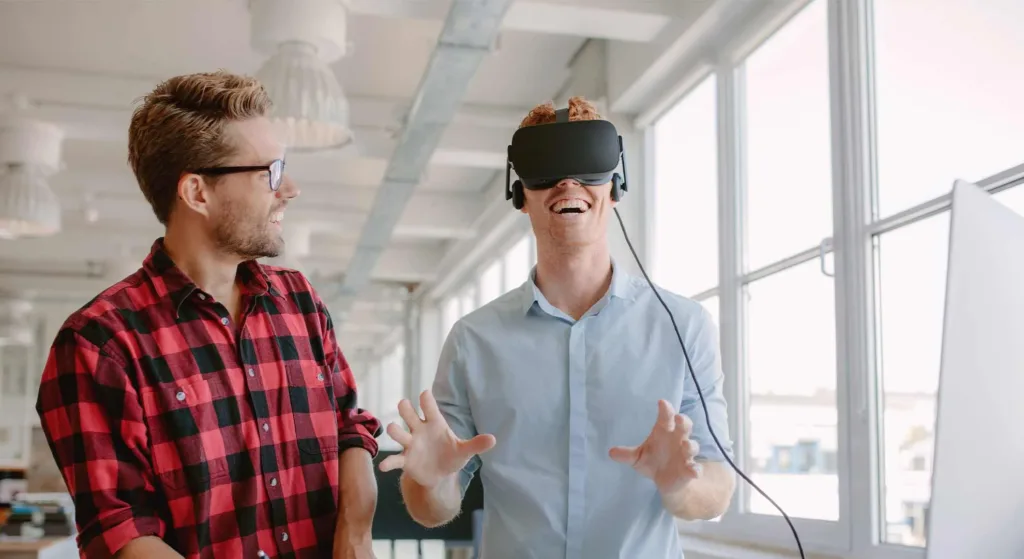Transforming the Workplace Learning Experience

Set in the year 2045, 2018’s much talked about science fiction film, Ready Player One, portrays how the majority of the population spent its time in a virtual reality (VR) to escape the real world.
Although no one on earth would wish for the catastrophic scenario illustrated in the movie, many companies are looking to recreate the VR experience in real life.
But why does it work so well?
Table of Contents
The VR Learning Experience Mitigates the Forgetting Curve
The immersive, experiential nature of virtual reality leads to better recall according to TechCrunch writer John Biggs. Many businesses are experimenting in this space today and are already using technologies, such as augmented reality (AR), mixed reality (MR), and virtual reality (VR), to create superior elearning content to mimic experiences based on the premise that if you can increase memory recall in your learners, then it’s safe to assume your training program is more successful.
But what specifically should companies be using this technology for?
In this article, I will, along with client examples, outline use cases for corporate learning experiences using VR technology to help you determine whether VR is right for your learning needs. I will also look at some steps you can take to adopt VR/AR learning experiences in your business.

Applying VR and AR to the Corporate Learning Experience
The market for VR training is fueled by countless situations where it is expensive, dangerous, or just impractical to create a real-life simulation that works together with employees, especially millennials, who expect to be working in a ‘smart office’ in the near future.
Research indicates that many employees do not find their current office smart enough, and 49% of Gen Z employees in Singapore believe that VR will revolutionize work. VR is one such technology that helps make the workplace ‘smart’ by making people more productive at work.
Bringing together VR and AR in the office sounds like science fiction, but this technology has the potential to take team collaboration to the next level. For example, we all use web-based tools like Webex, Zoom, and FaceTime today, but it doesn’t matter how advanced video conferencing becomes – there’s just something that is lost when looking at your co-worker on a screen.
VR and AR could potentially remove any challenges associated with remote working. Also, we all have endless sticky notes and papers on our desk, and even the most organized of us get overwhelmed with the volume of information we process every day. But what if we could simply swipe the data around like Tony Stark in his lab?
We’re not quite there with holograms yet, but the way Tony ‘swipes’ information around is technologically possible with VR. The potential is limitless, yet most companies would rather send employees to a video-based online learning program and cross their fingers that they learn something rather than go down the VR road.
Why is that? Because only the biggest companies can afford this.
Oil companies like Shell spend millions of dollars creating simulations of oil wells and refinery operations, and IT companies like IBM spent tens of millions of dollars on sales simulations coaching sellers on sales calls, presentations, and behavior. But the market is nascent, and not many companies have jumped on the bandwagon to take advantage of this soon to be $6.3 billion VR market opportunity, despite the clear benefits.
Unlike any other training method, VR enables collaboration, and repeated simulation opens up entirely new learning possibilities when it comes to shared experience and collaboration, ‘seeing the unseen’, and testing scenarios.
Improving the onboarding experience is a goal for just about every company, whether it’s for internal purposes or for SaaS onboarding. Some notable real world applications are for employee onboarding, where VR provides an ideal first touch point for many employees before they’ve even started their job.
It helps to build confidence, especially in high stress jobs or ones that involve client interaction, helping new employees become familiar and comfortable within the new workplace environment and more invested and motivated in their work.
Improving the Employee Learning Experience with Gamification
Gamification is one method of VR onboarding that is showing particular success, as it’s known to be one of the best onboarding strategies because it makes the experience more fun and immersive. Using advanced gamification techniques, such as VR-enabled gamification, will not only help you better showcase your company but it will also transform the tedious and lengthy onboarding process to create a highly engaging, personalized experience like SAP Switzerland did using VR and dramatically reduce your costs of new employee onboarding.
Improving onboarding experience is a goal for just about every company. See how #SAP Switzerland is accomplishing this using #VR. https://t.co/7kPl6VM9ry
— Brigette McInnis-Day (@BMcInnisDay) February 28, 2018
The combination of simulation and repetition seems to be extremely valuable in the training world, with VR being used more and more to help employees better interact with their customers. By teaching employees how to deal with specific situations, they become more relaxed during interactions through repetition and better understand their customers as a result.
There are some great examples in the retail industry. For example, Walmart started training employees at its Academies using the Oculus Rift in preparation for the Black Friday rush.
Black Friday is a very specific day where stress is high and customer interactions are plentiful. By simulating that experience in VR before the day, employees were better prepared and relaxed for the actual day itself.
The experience is as good as real, and learners are able to understand what it would be like when the store is packed full of people and how they would need to serve customers in a rush. Learners feel like they’re in the store and hear, see, and feel all the pressure of an employee, and the system literally coaches learners on exactly what to do and what not to do.
When it comes to learning and training, many tech enterprises, including Dell, see huge scope for VR. In manufacturing, pharma, or consumer good companies, where employees need information at their fingertips, VR can be game changing.
For example, if a sales employee goes to a customer for showcasing a product, instead of showing long PPTs or demo videos, they can showcase the live product with the help of virtual reality. You could even argue that it decreases the time of the sales cycle.
We’ve seen in these examples that companies are leveraging learning-focused VR technology to turn novices into experts faster and more effectively than ever before. But how do you know if VR is right for your particular business? What are the challenges and where do you start?

Is VR Suitable for My Particular Learning Experience Needs?
Traditional corporate elearning experiences can fall flat when it comes to training for jobs that require hands-on learning. VR can address this gap with learning simulations that reach a large group of people and is best applied when the knowledge that learners must acquire is complex to a point where learners must try and deal with difficult-to-observe phenomena that may occur rarely or in dangerous workplace scenarios.
A good example of this is firefighters or policemen or any public safety and emergency scenarios where the consequences of failing to act correctly have significant and/or life-threatening consequences. For these scenarios, VR-based training may well be an effective choice for faster and better learning at lower cost.
But how well can VR technology be implemented in other industries where absorbing complex knowledge is a must?
VR technology offers immersive learning opportunities for an increasingly broad range of experiences, and VR training offers measurable improvements in learning outcomes, such as in tasks that range from flying advanced jets and making a chicken sandwich to handling dangerous chemicals.
In the automobile industry, Audi is pioneering VR technology to change the face of its customer learning experience. Audi customers can configure their new Audi and experience their dream cars virtually and in real time using a VR headset.
This technology has proven successful in attracting buyers, improving their time at dealerships, and even forming a stronger emotional attachment to a car that they helped create. The Audi VR experience increased new car sales from 60 percent to 70 percent, which just goes to show how powerful this technology is in disrupting traditional sales strategy.
It’s safe to say that VR/AR is no longer a hype and that it is has successfully been applied to various industries not limited to the public sector in order to create next generation learning experiences.
The possibilities for VR learning seem limitless, and with that in mind, let’s now consider some potential steps to take if you are considering adopting this technology for your business.

Creating a VR/AR-Based Learning Experience for Your Business
When implementing any new technology, most would agree it’s somewhat daunting. The concept is initially exciting, especially when considering the revolutionary benefits VR can bring to a corporate learning experience.
However, many business leaders are concerned about the complexity of technical integration with their existing infrastructure environments and high upfront costs given that most companies do not have an in-house expert creating AR/VR experiences and need to hire a third party.
Up until now, AR/VR has been associated with cool, new gaming technology, so it will take some time before we can expect this technology to be fully adopted in other industries and as a corporate learning tool.
Even if adoption is taking off in several industries today, some industries are hesitant to invest without further studies and proof of ROI.
At the very least, innovating and adopting new technologies certainly requires a lot of thought around the ‘why’ and what impact it will have on your employees, customers, company culture, and society in general.
Companies need to create a company culture that perceives the usage of new technologies like VR/AR as a means to an end – that end being the improvement of the company bottom line and the facilitation of individual employee success.
As outlined in Dell Technologies’ REALIZE 2030: The Next Era of Human-Machine Partnerships, 85% of the jobs that will exist in 2030 haven’t even been invented yet and the skills they’ll require haven’t been scoped out. To get ahead, people will need to learn in the moment using new technologies such as VR, therefore making the ability to gain new knowledge more valuable than the knowledge itself.
If you’re thinking about implementing VR/AR technology to enhance the learning experience, then consider these three points before doing so:
- Understand your corporate learning needs. Consider the type of knowledge your employees need to consume and how they should be using that knowledge within their job roles. This will help determine if VR is right for your company and where exactly the fit is with your training and cultural needs.
- Estimate the ROI. Assess the expected benefit from the training in terms of increased business performance, decreased errors, and potential productivity gains. Then, line up those benefits against expected costs. The cost and difficulty in creating VR content are critical parameters, and a significant investment in VR is needed to make it a reality for your business.
- Start small, think big, and scale out. Test out a pilot program and see how it goes and how it is adopted. Learn from your pilot program and build out a larger use case and deployment plan from there.
While VR is going to take time to become a reality in the enterprise sector, an increasing number of vendors are focusing on the virtual workplace and innovations in this space are growing at a rapid pace.

Modern Learning Experiences for Future Generations
Companies like Microsoft have already introduced this technology along with Facebook via their Oculus for Business, Oculus Desktop, and Facebook Spaces initiatives.
Organizations adopting VR/AR technology can certainly expect better learning experiences at increasingly lower costs with a rapid return on investment, and its implementation is far less intimidating than it may seem.
Children born today will likely grow up taking virtual environments for granted (assuming that VR will be part of every classroom as experts predict). It remains to be seen how this will shape their understanding of reality. The next generation will likely have a different view of what reality is. For example, today’s children may consider intelligent assistants, whether within a VR context or in everyday life, as nearly as real as their parents and teachers!
As with any technology, VR is a tool, not a magic weapon. Integrating VR into a corporate learning experience doesn’t guarantee performance improvements, and the next few years will no doubt bring many VR disappointments along with huge successes.
HR leaders should carefully plan, program, and design learning and training goals for VR as they do for any other corporate training effort, including tailoring programs around understanding the exact knowledge that a company needs learners to absorb and what they should then do with that knowledge.
HR leaders should also bear in mind that VR technology is not about replacing a traditional learning experience or experiences, but rather about supplementing them and recreating regular work experiences.
Are you interested in learning more about how technology is affecting the way we learn in the workplace? Do you want to test your current knowledge when it comes to digital transformation?
You can do so with our quiz! Find out how much you already know about digital transformation and see if you’re an expert already. Don’t be afraid to share your results!


